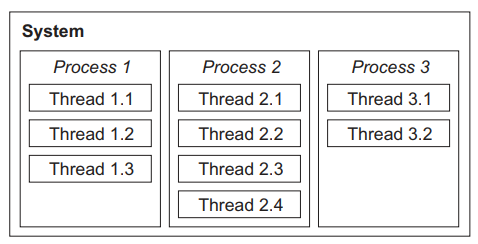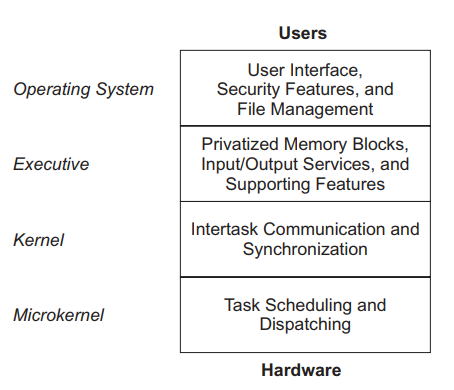Unit – 3
Real time operating system
Q(1) Explain the Real Time Kernels in detail.
A 1)
Real Time Kernels:
Process:

Fig.1: Hierarchical relationships between the system

Fig.2: Layers of Hardware, While Kernel Being the second Layer of it.
Q(2) Explain the Inter Task Communication & Synchronization in detail.
A 2)
Inter Task Communication & Synchronization:
shown in Figure 2.
blocks, input/output services, and other supporting features.
Q(3) Explain the Basic inter-task communication facilities provided by RTOS in detail.
A 3)
Basic inter-task communication facilities provided by RTOS:
ii. Event Flag Groups :
iii. Semaphores :
iv. Mailboxes :
v. Ques :
vi. Mutexes :
Q(4) Explain the System Services for Application Programs in detail.
A 4)
System Services for Application Programs:
Q(5) Explain the Linear Buffers , Ring Buffers, Mailboxes, Semaphores in detail.
A 5)
1. Linear Buffers:

Fig.3: Readers and writers problem, with n readers and m writers; the shared resource is a bounded buffer.
2. Ring Buffers:

Fig.4: A ring buffer; tasks write data to the buffer at the tail index and read from the head index.
3. Mailboxes
queues are used at both the head and tail to control access to the ring buffer.
4. Semaphores:
Example: Serially Reusable Resource.
Q(6) Explain the Memory Management Issues in detail.
A 6)
Memory Management Issues:
This overhead is a significant component of the context - switch time and must be minimized.
Q(7) Explain the Stack and Task Control Block Management in detail.
A 7)
Stack and Task Control Block Management:
restored in order to switch tasks successfully.
systems.
Multiple - Stack Arrangement:
Using multiple stacks in real - time systems offers clear advantages:

Fig.5: Multiple - stack arrangement
Q(8) Explain the Selecting Real-Time Operating System and Buying versus Building in detail.
A 8)
Selecting Real-Time Operating System:
• Fault tolerance
• Maintainability
• Predictability
• Survival under peak load
• Timeliness
Buying versus Building:
In short, commercial RTOSs are best used when they can satisfy the response – time requirements at a competitive cost, and if the real - time system must run on a variety of platforms.
Q(9) Explain the Selection Criteria and a Metric for Commercial Real - Time Operating Systems in detail.
A 9)
Selection Criteria and a Metric for Commercial Real - Time Operating Systems:
• Fault tolerance
• Maintainability
• Predictability
• Survival under peak load
• Timeliness
Q(10) Explain POSIX – A case study in detail.
A 10)
POSIX – A case study:
The advent of microprocessors circa 1980 created an opportunity for new computer vendors, but they required applications software. To establish the critical mass needed to attract application suppliers required an environment that supported portability between systems. This required a common operating system (OS) interface. AT&T’s UNIX was a candidate OS portable across these diverse processors. Emerging vendors, and others building on microprocessor technology turned towards collaborative standardization to address this objective1. This vendor and processor independence was an essential objective for “Open Systems” standards. The POSIX (Portable Operating System Interface) effort focused on this as the foundation for portable applications. POISIX is credited with increasing the market for UNIX systems by 30% [18] – an economic impact approaching 100 billion dollars.
A series of factors created the environment that would bring
the world’s largest and smallest computer vendors together
in the POSIX operating system standards effort:
individual net worth over this time frame. Both resulted from addressing the need for operating systems for applications portability.
a)The emergence of microprocessors, most notably the
Motorola 68000, which had the capacity to host a
full UNIX implementation.
b)The release of the UNIX operating system for
commercial licensing by AT&T.
3. 1986 – Trial use (herding cats):
The decision to create a Trial Use standard rather than full use was based on the perception that we could gain consensus faster with that approach, and also use the visibility of that work to bring in a broader community.
4. 1988 – Full Use:
This version also contained conformance clauses that defined both “system “conformance and “application” conformance.